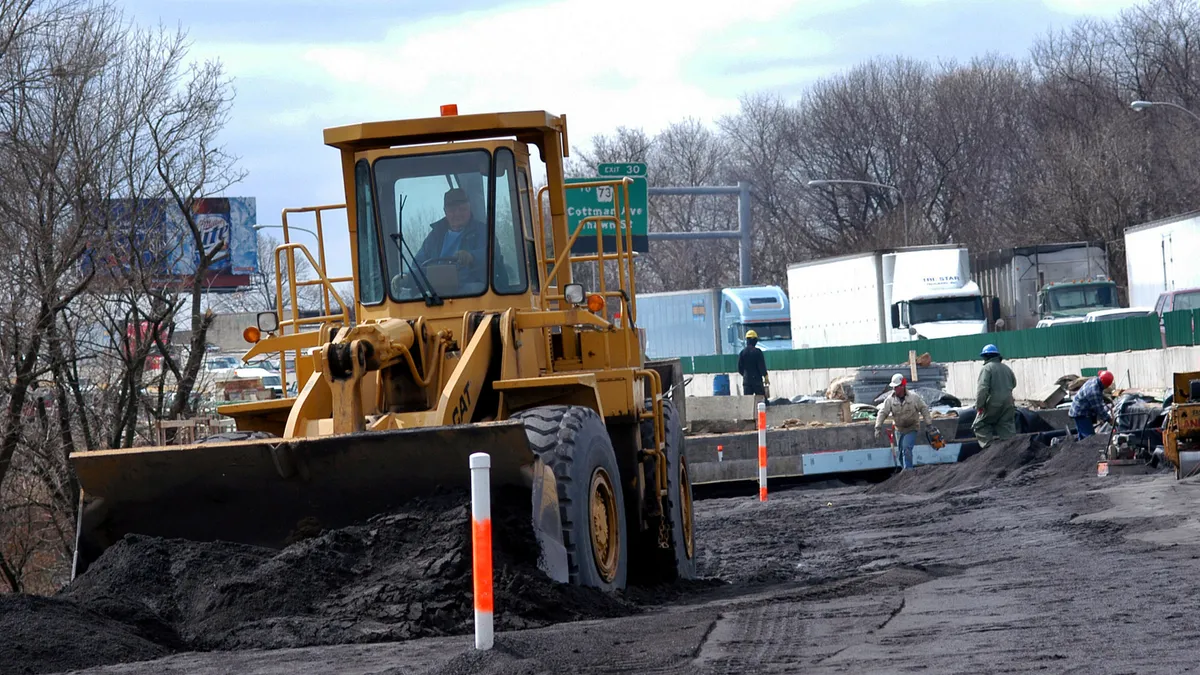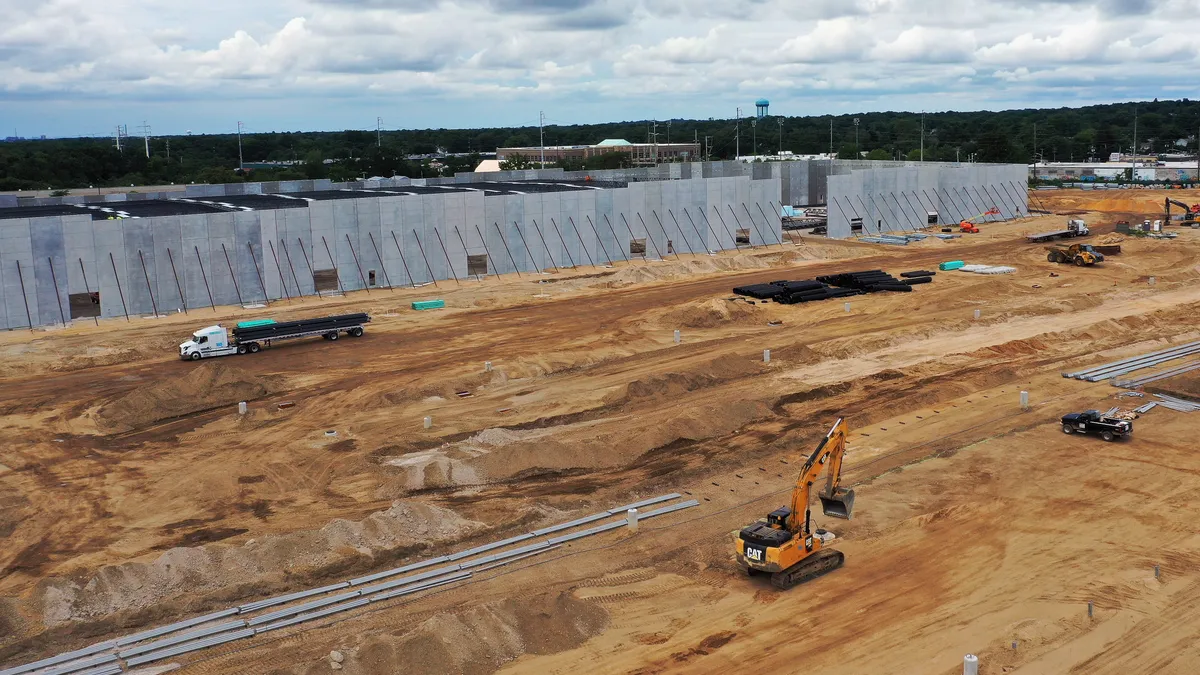When Adam Thalhimer, director of research at Richmond, Virginia-based investment advisor Thompson Davis & Co., evaluates the financial health of a public construction firm, earnings is always his first consideration.
But backlog isn't too far behind. In fact, Thalhimer said it is in his top three considerations of a public company's health. "Some projects are less than a year," he said. "Some projects are longer than a year, but I think something like 90% of backlog can be translated to revenue in the next four quarters."
While backlogs are universally a sign of health and future revenue, not all of them are the same. COVID-19 pandemic hit many smaller, private construction companies hard, but public companies were able to withstand the pandemic. Four companies tracked by Construction Dive saw their backlogs grow more than 25% from the first quarter of 2020 to the third quarter of 2021. Even large multinational companies, like Skanksa saw backlogs increase. Now, with infrastructure dollars soon to flow into the economy, backlog growth seems destined to take off, experts say.
COVID-19 volatility
Coming into the pandemic, many public construction companies were amassing unprecedented backlogs. For instance, Los Angeles-based general contractor Tutor Perini and Houston-based specialty construction company Orion Group Holdings set record highs for backlogs in 2018 and 2019.
For the nine public companies that Thalhimer tracks, total backlog was up 24% from the first quarter of 2018 to the first quarter of 2020. It rose 10% between the first quarter of 2019 and the first quarter of 2020.
"They came into the pandemic with a lot of backlog," he said.
How public companies' backlog changed during COVID-19
| Company | Q1 2020 backlog | Q3 2021 backlog | % change in backlog |
|---|---|---|---|
| Construction Partners | $0.58B | $0.97B | 67.2% |
| Williams Industrial Services | $0.47B | $0.67B | 42.6% |
| WSP (converted to USD) | $6.07B | $7.9B | 30.1% |
| Great Lakes Dredge & Dock | $0.48B | $0.6B | 25% |
| Granite* | $3.64B | $4.33B | 19% |
| Jacobs | $23.29B | $26.63B | 14.3% |
| Skanska (converted to USD) | $20.10B | $22.56B | 12.2% |
| Sterling Construction Co. | $1.43B | $1.41B | -1.4% |
| Orion Group Holdings | $0.61B | $0.57B | -6.5% |
| AECOM | $41.61B | $38.58B | -7.3% |
| Tutor Perini | $10.56B | $8.41B | -20.4% |
| Matrix Service Co. | $0.73B | $0.56B | -23.3% |
| Fluor | $31.39B | $21.03B | -33% |
SOURCE: Companies' public filings.
*Granite expanded how it counts backlog in mid-2021 to include all "committed and awarded projects," or CAP, and not just contracted backlog, which added to its final Q3 2021 number
But even after COVID-19 hit, the backlogs for the companies in Thalhimer's sphere didn't take a tumble. Instead, they slid only slightly, hitting a low in the third quarter of 2020. But Thalhimier doesn't think that decline was because projects were being canceled. Instead, construction companies were able to complete work faster as productivity increased.
"A lot of my companies actually had fantastic 2020's," Thalhimer said. "There was nobody on the road. If you had a project that was permitted and ready to go when COVID hit, if anything, it helped your margins."
Other analysts argue the public companies did suffer from the pandemic, seeing fewer contracts awarded in 2020, which also flattened out backlogs.
"In a year like last year, where there was so much uncertainty for the first half of the year, no one really knew what they can even safely get away with during their day-to-day lives," said Matt Arnold, senior equity analyst for St. Louis-based financial services firm Edward Jones. "So last year, a lot of decision-makers were deferring any type of commitment."
Arnold also said construction work slowed at the beginning of 2020, which may have extended backlogs.
"For the first part of the year, a lot of these projects were just kind of stalled out and couldn't move forward at all," he said. "So the backlog sits there."
While this may lead to backlog growth, it isn't necessarily healthy. In fact, Arnold called it "stale" growth.
"It's just a sign of the business being disrupted and the project not moving forward," he said.
Later in the year, projects began to move forward, according to Arnold. When that occurred, companies were able to complete work and find new projects.
"In many cases, that's when backlogs started being burnt down to a greater extent," he said.
While neither of the two companies that Arnold covers, Dallas-based technical, professional and construction services firm Jacobs Engineering Group and WSP Global, experienced backlog declines in 2020, they saw project delays that negatively impacted revenue.
"By late 2020, both saw an acceleration in revenue growth as projects were less impacted by the pandemic," Arnold said.
Krzysztof Smalec, an equity analyst on the industrials team for Chicago-based financial services firm Morningstar, also thinks COVID-19 restrictions hurt some companies' ability to work through their construction backlogs. Still, he didn't see a whole lot of project cancellations.
"It was more clients waiting for more certainty," he said.
While some public companies, like Watsonville, California-based civil general contractor and construction material producer Granite Construction, saw backlogs fall, the situation could have been a lot worse. After it made an accounting change to expand the types of contracts included in its reported backlog in the second quarter of 2021 to encompass all "committed and awarded projects," its projected pipeline grew, at least on paper.
Arnold and Sean Eastman, an equity research analyst at Cleveland-based corporate and investment bank KeyBanc Capital Markets, both called backlogs "resilient" through 2020 and into 2021 for the companies that they cover, such as Jacobs and Texas-based engineering and construction company Fluor.
"It's hard to paint with a wide brush over the last year or two," Eastman said. "Some end markets have accelerated, and some have seen a lot of pressure. But I think, overall, the resilience has been pretty surprising, at least within my coverage group."
Second-quarter recovery
While analysts, depending on the companies they cover, may have differences of opinion on how much work slowed in 2020, most seemed to agree that backlogs began to grow earlier this year. For instance, Williams Industrial Services saw its backlog jump from $460.6 million in the first quarter of 2021 to $664.4 million in the second quarter.
By the second quarter of 2021, Thalhimer said backlogs once again began to expand. Arnold expects backlogs only to grow from there "for all the right reasons" (as opposed to construction firms not being able to complete work) as companies work through projects and revenue and profits increase.
"Now, we're in a situation where the economy is rapidly healing," he said. "The pandemic is not over, but people have a far greater sense of what they can and cannot do day-to-day. It's clear that a lot of these things can start moving forward again. So what you're seeing right now is that backlogs are beginning to grow."
Add the dollars flowing into the economy from the recently signed federal Infrastructure Investment and Jobs Act, and the expectation is that backlogs will only expand further in the near future.
"Given what's going to take place now with this infrastructure bill and other things, it seems very likely that backlogs are going to be on an upward trajectory for several years," Arnold said.
Yet, one central question revolves around when these infrastructure dollars will hit contractors' books.
"With the exact timing of how this ultimately percolates into backlogs and earnings for E and C [engineering and construction] companies, there's still some uncertainty there," Eastman said. "But my sense is, going into 2023, there should be some momentum from this funding."
Thalhimer thinks the money will hit sooner than some people suppose. "It does cover fiscal '22," he said. "Everybody said, 'Oh, we won't see anything from this for a year.' I'm not completely sure that is true."
Future constraints
While the infrastructure package has the potential to push backlogs to unprecedented levels, analysts have some concerns about companies being able to stay ahead of the new work.
"When you're dealing with something like this [the infrastructure package], project delays and things like that are to be expected as it is," Arnold said.
Labor is already limiting projects to the point where some companies are estimating that their revenue would be 5% higher if labor was more plentiful, according to Thalhimer.
Others see the same constraints.
"None of us have been through a pandemic where the economy shut down and reopened," Arnold said. "And everybody is trying to figure out when the labor force is going to go back to work. It's just a little bit more cloudy than normal in terms of how this plays out."
The clogged supply chain could also slow down the construction process. Add that to labor woes, and Arnold thinks backlogs will start to build in 2023. And it could take longer than expected to work through infrastructure projects.
"I think there will be limiting factors, even a couple of years out," Arnold said. "If these companies all get that busy, it's going to be tough for them to be as prepared as they want to be in terms of actual capabilities to deliver on certain projects."















